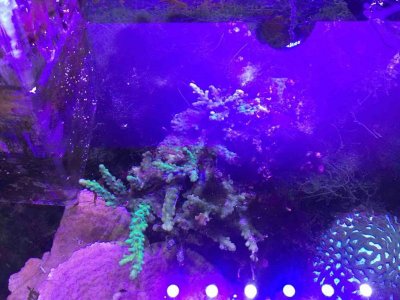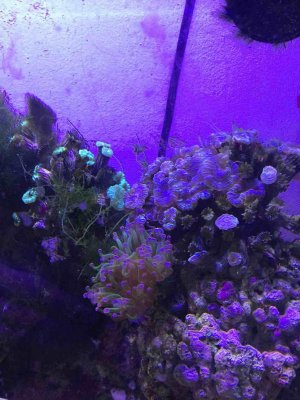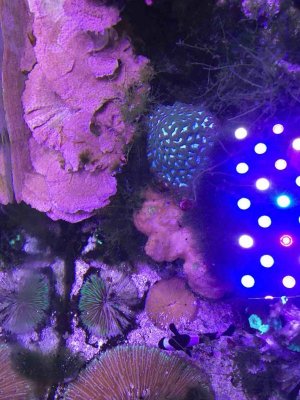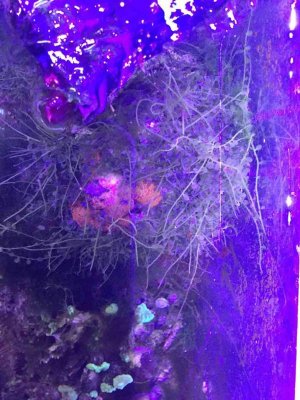According to my Acorpora, I do any way.
He has recently been turning 'dingy' and his polyps are not extending. Or not nearly as much as they used to. I'll try to put all the relevant info most briefly
Parameters: 1230pm; ph 8.26, temp 79.9, conductivity 33.7, alk dKH 6.8 (but I don't trust it, the test kit is about a year old), CA 250 from about a week ago (Don't trust this either, but have begun more frequent dosing). NO other test results of significance. I don't test for Mg b/c I don't dose it.
Setup: Neptune controller, RapidLED fixture with Cree LED (no kit, their recommended setup), sump, probes for pH and conductivity. Peristaltic pumps for dosing 2-part solution. This recipe I've been using for over three years: http://www.reefdup.com/2012/12/16/how-to-make-2-part-dosing-solutions/
Livestock: plate corals, Acan, montipora, poker star, candy canes, hammer. All doing well. The plate corals seem to be less than happy too, but not nearly as bad as the Acro. For a time, when I changed a lighting program, the candy canes began to recede but recovered when I returned it to previous settings.
I did recently add a 'moon' cycle for about an hour or two, but at a very low percentage, about 2-3
I lowered some flow in the tank b/c of the distressed plates
Moved the CA dose to the daytime to allow for more frequent dosing
ALK doses at nite based upon a pH threshold of 8.14. This will make about 8.37 at the high during the day
The ALK effectively doses about every 3-5 days based upon this setup; about 6-sec bursts with 2hr delay for the next dose
I did twiddle with the lighting, no more than 5%. But returned it to as previously set soon after.
I began using the APEX lighting tool for the mix and white recently, but not the blue
Help! My Acro is slowly shuffling off this mortal coil. I'm sure it's my fault.
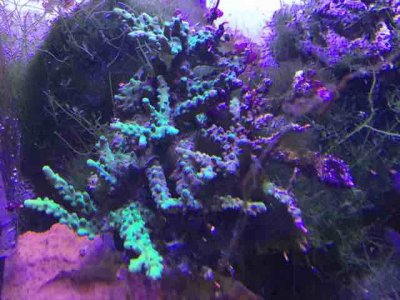
He has recently been turning 'dingy' and his polyps are not extending. Or not nearly as much as they used to. I'll try to put all the relevant info most briefly
Parameters: 1230pm; ph 8.26, temp 79.9, conductivity 33.7, alk dKH 6.8 (but I don't trust it, the test kit is about a year old), CA 250 from about a week ago (Don't trust this either, but have begun more frequent dosing). NO other test results of significance. I don't test for Mg b/c I don't dose it.
Setup: Neptune controller, RapidLED fixture with Cree LED (no kit, their recommended setup), sump, probes for pH and conductivity. Peristaltic pumps for dosing 2-part solution. This recipe I've been using for over three years: http://www.reefdup.com/2012/12/16/how-to-make-2-part-dosing-solutions/
Livestock: plate corals, Acan, montipora, poker star, candy canes, hammer. All doing well. The plate corals seem to be less than happy too, but not nearly as bad as the Acro. For a time, when I changed a lighting program, the candy canes began to recede but recovered when I returned it to previous settings.
I did recently add a 'moon' cycle for about an hour or two, but at a very low percentage, about 2-3
I lowered some flow in the tank b/c of the distressed plates
Moved the CA dose to the daytime to allow for more frequent dosing
ALK doses at nite based upon a pH threshold of 8.14. This will make about 8.37 at the high during the day
The ALK effectively doses about every 3-5 days based upon this setup; about 6-sec bursts with 2hr delay for the next dose
I did twiddle with the lighting, no more than 5%. But returned it to as previously set soon after.
I began using the APEX lighting tool for the mix and white recently, but not the blue
Help! My Acro is slowly shuffling off this mortal coil. I'm sure it's my fault.


